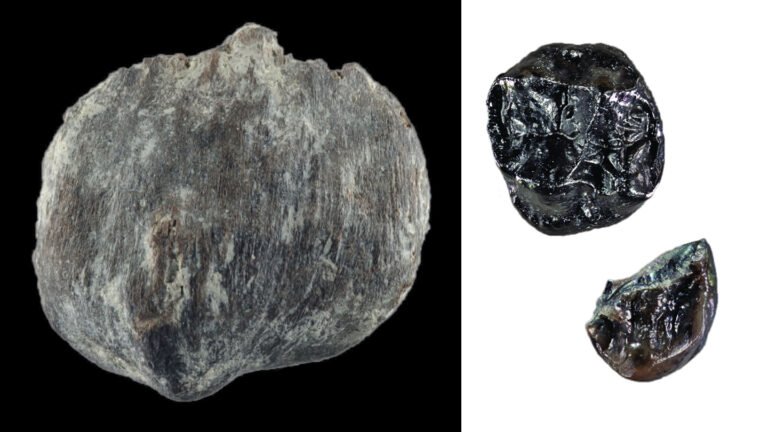Two lines of ancient apes, including what may be the smallest great ape yet, lived alongside each other in Europe, fossils discovered in a Bavarian clay pit indicate. It’s the first time that different species of ape, each with a distinctive body style and diet, have been found coexisting outside of Africa, researchers say.
Germany’s Hammerschmiede site previously yielded 11.6-million-year-old fossils of Danuvius guggenmosi (SN: 11/6/19). That creature, categorized as an extinct great ape, gained fame as possibly the oldest known upright walker, a team led by paleontologist Madelaine Böhme of Eberhard Karls University of Tübingen in Germany reported at the time.
Now Böhme and colleagues report that three fossils found in the Danuvius sediment layer come from a newly identified great ape dubbed Buronius manfredschmidi. A partial upper molar and a kneecap found next to each other probably represent a young, sexually immature individual, Böhme says. A partial lower premolar excavated about 25 meters from the other fossils belonged to an adult, the team reports June 7 in PLOS One.
Based on the size and shape of those fossils, the researchers suspect Buronius weighed only around 10 kilograms, making it the smallest known great ape. Modern siamangs, a type of gibbon classified as a lesser ape, also weigh around 10 kilograms.
The few fossils are enough to start piecing together Buronius’ lifestyle, the team contends. A thin outer layer of tooth enamel would have been suited to a diet of soft foods. Several features of the relatively short, thick fossil kneecap enabled skillful climbing. That suggests that Buronius ate leaves high in trees and sweet fruits in the summer and fall.

Danuvius, which grew to about twice the size of Buronius, had thickly enameled teeth that could manage tough foods, such as mollusks, nuts, roots, underground stems and meat from small animals.
If Böhme’s group is correct, Hammerschmiede represents the first locale outside Africa to have hosted two Miocene great ape species at the same time. The Miocene Period extended from about 23 million to 5 million years ago. Miocene great apes belong to an evolutionary family that includes modern chimps, gorillas, orangutans and humans.
Evidence that Danuvius and Buronius survived on different resources in the same place “shows that ecosystems in the Miocene of Europe enabled, perhaps even forced, the evolution of diverse ape lineages,” Böhme says.
With the addition of Buronius, European fossil ape genera related to modern great apes from between roughly 16 million and 6 million years ago now number 16, she says. That’s more than twice as many as have been found in Africa dating to the same period.
But a total of only three Buronius fossils leaves room for uncertainty about the ancient creature’s evolutionary status — or whether it’s a separate species at all.
For instance, some features of the two partial teeth — especially the more complete upper molar — resemble those found on fossil teeth from one branch of a group of Eurasian apes called pliopithecoids, says paleoanthropologist Clément Zanolli of the University of Bordeaux in France. Pliopithecoids have no living descendants.
Imaging studies of internal tooth structure will clarify where Buronius stood in the gallery of ancient European apes, Zanolli suspects. However those investigations pan out, the coexistence of two types of apes at Hammerschmiede underscores Europe’s influential role in Miocene primate evolution, he says.
But perhaps only Danuvius held court at the German site, says paleoanthropologist Sergio Almécija of the American Museum of Natural History in New York City. The two small teeth described in the new report might have belonged to Danuvius infants, he suggests. And the kneecap, which Böhme’s team regards as that of a young individual, is as large as the kneecaps of smaller modern orangutan adults, raising further questions about its species identity, Almécija says.
More fossils are needed to determine if the Buronius kneecap instead came from a young Danuvius individual that had not reached adult size, adds paleoanthropologist Kelsey Pugh of Brooklyn College, City University of New York.
Hammerschmiede discoveries “highlight how much we don’t know about the evolution of the great ape and human family, and of other primates, during the Miocene in Europe,” Almécija says.
[ad_2]
Source link


